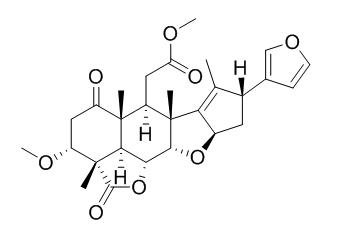2,3-Dihydro-3α-methoxynimbolide induces apoptosis via both mitochondrial and death receptor pathways in stomach (AZ521) cancer cell line.
Providing storage is as stated on the product vial and the vial is kept tightly sealed, the product can be stored for up to
24 months(2-8C).
Wherever possible, you should prepare and use solutions on the same day. However, if you need to make up stock solutions in advance, we recommend that you store the solution as aliquots in tightly sealed vials at -20C. Generally, these will be useable for up to two weeks. Before use, and prior to opening the vial we recommend that you allow your product to equilibrate to room temperature for at least 1 hour.
Need more advice on solubility, usage and handling? Please email to: service@chemfaces.com
The packaging of the product may have turned upside down during transportation, resulting in the natural compounds adhering to the neck or cap of the vial. take the vial out of its packaging and gently shake to let the compounds fall to the bottom of the vial. for liquid products, centrifuge at 200-500 RPM to gather the liquid at the bottom of the vial. try to avoid loss or contamination during handling.
Chem Biodivers. 2014 Apr;11(4):505-31.
Limonoids from Azadirachta indica var. siamensis extracts and their cytotoxic and melanogenesis-inhibitory activities.[Pubmed:
24706622 ]
Six new limonoids, 7-benzoyl-17-epinimbocinol (5), 3-acetyl-7-tigloylnimbidinin (8), 1-isovaleroyl-1-detigloylsalanninolide (15), 2,3-Dihydro-3alpha-methoxynimbolide (16), deacetyl-20,21-epoxy-20,22-dihydro-21-deoxyisonimbinolide (26), and deacetyl-20,21,22,23-tetrahydro-20,22-dihydroxy-21,23-dimethoxynimbin (27), along with 28 known limonoids, 1-4, 6, 7, 9-14, 17-25, and 28-34, and two known flavonoids, 35 and 36, have been isolated from the extracts of bark, leaves, roots, and seeds of Azadirachta indica A. Juss. var. siamensis Valeton (Siamese neem tree; Meliaceae).
METHODS AND RESULTS:
The structures of the new compounds were elucidated on the basis of extensive spectroscopic analysis and comparison with literature data. All of these compounds were evaluated for their cytotoxic activities against leukemia (HL60), lung (A549), stomach (AZ521), and breast (SK-BR-3) cancer cell lines. Eleven compounds, 1, 2, 4-7, 13, 16, 17, 29, and 30, exhibited potent cytotoxicities against one or more cell lines with IC50 values in the range of 0.1-9.3 μM. Compound 16 induced apoptotic cell death in AZ521 cells upon evaluation of the apoptosis-inducing activity by flow cytometric analysis. Western blot analysis on AZ521 cells revealed that compound 16 activated caspases-3, -8, and -9, while increasing the ratio of Bax/Bcl-2.
CONCLUSIONS:
This suggested that 16 induced apoptosis via both mitochondrial and death receptor pathways in AZ521.



